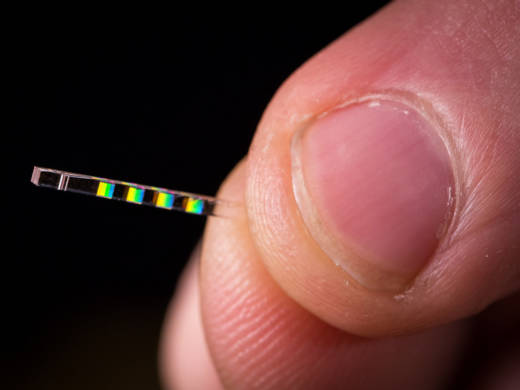"We need to focus the electrons," Byer says. "We need to bunch them so they surf the wavelength of light right at the crest, so they get the maximum acceleration."
Byer and his colleagues are working on those challenges in a laboratory in the basement of the Spilker Engineering and Applied Sciences building on the Stanford campus. Byer took me on a tour there.
We put on glasses to protect our eyes from the powerful laser light used in the pint-sized accelerator.
A big red emergency shut-off button attached to a shelf suggests this is not equipment to trifle with.
Peter Hommelhoff of the Friedrich-Alexander-Universität Erlangen-Nürnberg in Germany says one of the big challenges is to keep the electrons in the accelerator traveling where you want them to.
"The acceleration channel is very narrow, so you have to generate a very, very narrow electron beam that you can send through the channel," Hommelhoff says.
"It's a little like threading an invisible needle," says Dylan Black, a Stanford graduate student in physics.
Testing their accelerator requires lasers and lenses and pumps scattered around benches in the lab, it takes up a fair amount of space. But this is just a prototype.
Black points to a bright circle of light on a monitor's screen.
"That there is a picture of what the electron beam would look like if you put your eye right in front of the beam," Black says.
"Which I would not recommend," interjects Ken Leedle, a research engineer working on the accelerator-on-a-chip project.
I asked R. Joel England, a physicist at the SLAC National Accelerator Laboratory who has been working on the accelerator-on-a-chip project, how long it will be before the prototype turns into a working instrument.
"Depending on how much progress gets made, I would say five to 10 years," England says. England is enthusiastic about the promise of these small-scale accelerators.
"One of the applications could be to take one of the fairly bulky, 10,000-pound accelerator devices that's used in hospitals for radiation therapy and make that into something that's chip-sized," he says.
In addition to saving huge costs and space, it might eventually be possible to insert a chip-sized accelerator into a patient's body, where it could directly irradiate a tumor.
Even though it may take a decade or more, Robert Byer is convinced smaller accelerators will become a reality. His isn't the only lab working on the idea. And besides, he points out, new technologies often start out bulky. Take the first laser to come on the scene.
"Early on, lasers were big — and they were inefficient and they took all the power and water in your building to operate them," Byer says. "They got more and more efficient because we converted to semiconductor lasers and solid state lasers — and all of a sudden, lasers then became everywhere."
Even new mobile phones have lasers in them, Byer says.
The day of the accelerator on a chip, he believes, is coming.
Copyright 2018 NPR. To see more, visit http://www.npr.org/.
9(MDAxOTAwOTE4MDEyMTkxMDAzNjczZDljZA004))

9(MDAxOTAwOTE4MDEyMTkxMDAzNjczZDljZA004))